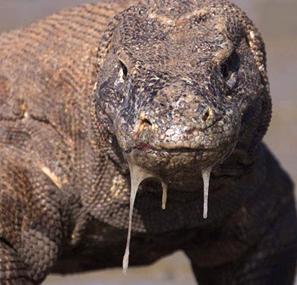Komodo National Park is located in the center of the Indonesian archipelago, between the islands of Sumbawa and Flores. Established in 1980, initially the main purpose of the Park was to conserve the unique Komodo dragon (Varanus komodoensis) and its habitat. In 1986, the Park was declared a World Heritage Site and a Man and Biosphere Reserve by UNESCO, both indications of the Park’s biological importance.
Komodo National Park includes three major islands: Komodo, Rinca and Padar, as well as numerous smaller islands creating a total surface area (marine and land) of 1817km (proposed extensions would bring the total surface area up to 2,321km2). Moreover, the Park includes one of the richest marine environments including coral reefs, mangroves, seagrass beds, seamounts, and semi-enclosed bays. These habitats harbor more than 1,000 species of fish, some 260 species of reef-building coral, and 70 species of sponges. Dugong, sharks, manta rays, at least 14 species of whales, dolphins, and sea turtles also make Komodo National Park their home.
The majority of the people in and around the Park are fishermen originally from Bima (Sumbawa), Manggarai, South Flores, and South Sulawesi. Threats to terrestrial biodiversity include the increasing pressure on forest cover and water resources as the local human population has increased 800% over the past 60 years. In addition, the Timor deer population, the preferred prey source for the endangered Komodo dragon, is still being poached. Destructive fishing practices such as dynamite-, cyanide, and compressor fishing severely threaten the Park’s marine resources by destroying both the habitat (coral reefs) and the resource itself (fish and invertebrate stocks).
skip to main |
skip to sidebar
Countries
Tourist destination
- Amazon Rain Forest (1)
- Angkor Wat (1)
- Asia (40)
- Australia (2)
- Ba Be Vietnam (1)
- Bagan Temples - Myanmar (1)
- Bali Islands - Indonesia (1)
- Bangkok Thailand (1)
- Beijing - China (1)
- Białowieża Forest - Poland (1)
- Bora Bora (1)
- Busan - South Korea (1)
- Cameron Highlands - Malaysia (1)
- Campudia (1)
- Chiang Mai Thailand (1)
- China (10)
- Colosseum of Rome (1)
- Combodia (1)
- Con Dao Vietnam (1)
- Dalat Vietnam (1)
- Egypt (1)
- Forbidden City - China (1)
- Great Barrier Reef (1)
- Great Wall - China (1)
- Guilin - China (1)
- Gwangju (1)
- Ha Long Vietnam (1)
- Hanoi - Vietnam (1)
- Ho Chi Minh City - Viet Nam (1)
- Hoi An Viet Nam (1)
- Hong Kong (1)
- Hua Hin Thailand (1)
- Hue Vietnam (1)
- Indonesia (4)
- Jakarta Indonesia (1)
- Kanchanaburi Thailand (1)
- Karnak Temple - Egypt (1)
- Koh Samui - Thailand (1)
- Komodo island (1)
- Korea (1)
- Kuala Lumpur Malaysia (1)
- Laos (1)
- Lhasa Tibet - China (1)
- Machu Picchu (1)
- Malaysia (4)
- Mexico (1)
- Mui Ne Vietnam (1)
- Myanmar (1)
- National Orchid Garden - Singapore (2)
- Ngorongoro Crater (1)
- North Korea (1)
- Orchard Road - Singapore (1)
- Pattaya Thailand (1)
- Penang - Malaysia (1)
- Petra - jordan (1)
- Phong Nha Ke Bang Vietnam (1)
- Phu Quoc Vietnam (1)
- Phuket - Thailand (1)
- Phuket Thailand (1)
- Poland (2)
- Sapa Vietnam (1)
- Sentosa Island Singapore (1)
- Shanghai (1)
- Singapore (5)
- Singapore Flyer (1)
- South Korea (3)
- Taman Negara - Malaysia (1)
- Teotihuacan (1)
- Thailand (10)
- The East Coast Islands - Thailand (1)
- The Floating Market - Thailand (1)
- The Great Ocean Road (1)
- Top 100 wonders (12)
- Universal Studios Singapore (1)
- Viet Nam (14)
- Vung Tau - Vietnam (1)
- Xian - China (1)
- Yangtze River - China (1)
Blog Archive
-
▼
2012
(73)
-
▼
June
(31)
- Lhasa Tibet - China
- Teotihuacan - Mexico
- The East Coast Islands
- Karnak Temple Complex in Egypt
- The Great Ocean Road - Australia
- Yangtze River - China
- Bagan Temples - Myanmar
- Orchard Road - Singapore
- Forbidden City - China
- Australia
- Victoria Falls
- Komodo island
- Gwangju - South Korea
- North Korea
- Angkor Wat Cambodia
- Hong Kong
- Great Barrier Reef
- Ho Chi Minh City - Viet Nam
- Guilin - China
- Białowieża Forest - Poland
- Poland
- Ngorongoro Crater
- Busan - South Korea
- Amazon Rain Forest
- Shanghai
- Iguazu Falls
- South Korea
- Machu Picchu
- Viet Nam
- Bali Islands - Indonesia
- Colosseum of Rome
-
▼
June
(31)
Copyright © 2011 travel-my-blog | Powered by Blogger



 6:11 PM
6:11 PM
 Unknown
Unknown












 Posted in:
Posted in: 
0 comments:
Post a Comment